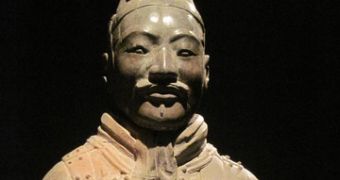A Chinese archaeological team has discovered the palace complex of China's first emperor, mostly known for the previously unearthed group of terracotta soldiers guarding his tomb, Chinese state media reports.
The newly unearthed palace contains 1 main building and 10 courtyard buildings surrounding it. The entire structure is about 820 feet (250 meters) wide and 2,264 feet (690 meters) long, Live Science reports.
Various remains, such as walls, doorways, sewers, as well as bricks and pottery have been unearthed.
Research has shown the structure of the complex was similar to that of other traditional Chinese buildings, consisting of a central axis aligned with a principal building.
Qin Shihuang in Xi'an's mansion was found within a large mausoleum complex believed to have been built all along the emperor's life, which is the size of a small city and was first discovered in 1974 by a group of farmers digging wells.
The most famous finding within the complex is a set of about 8,000 life-size terracotta soldiers, unearthed in 1974 and declared a UNESCO World Heritage Site in 1987.
Qin Shi Huang was born in 259 B.C. and became the king of the Chinese State of Qin in 246 B.C. He conquered the six separate Chinese states, becoming the first emperor of China in 211 B.B. He ruled the empire until 210 B.C., when he died during a tour of Eastern China, aged 49.
The first construction the young king ever accomplished was his own tomb. Historical sources suggest over 720,000 unpaid workers had been ordered to labor for the magnificent construction to be completed.
However, Qin Shi Huang's main tomb, containing the emperor's body, hasn't been unearthed yet, as archaeologists fear that starting the operation without a proper preparation could cause the site significant damages.
Scientists believe the remains are almost intact inside the tomb. There are also sources that suggest the burial chamber contains 100 rivers of mercury, different pieces of jewelry, a map of the empire and other “rare utensils and wonderful objects.”

 14 DAY TRIAL //
14 DAY TRIAL //